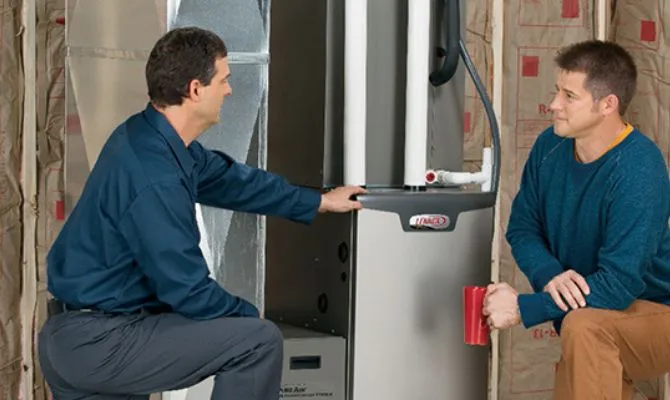You may have noticed a setting on your regular thermostat labeled “EM heat” and wondered what it’s for. Unfortunately, many people mistakenly think that it’s a setting for extra warmth during extremely cold temperatures, but this isn’t the case. “EM” actually stands for emergency, and it’s a secondary heating system that acts as a backup in case your primary heating fails. So, it’s important to know how to properly use it and not just switch it on without understanding its purpose.
That’s why we’ve created this guide to help educate you on the EM heat setting and the appropriate way to use it in your home. Remember, it’s always important to understand your home appliance settings before making any changes or adjustments.
What is Emergency Heat and What is “EM Heat” on a Thermostat Setting?
“EM heat” stands for emergency heat and it’s a setting on your thermostat that controls your home’s backup heating system. If you have this setting, you probably have a heat pump and a secondary heating source, like gas, oil, electric, or hot-water.
Typically, your heat pump is the primary heating source and only the secondary system is used when extra heat is needed. In colder climates, the secondary system is automatically used when the temperature drops below 35° Fahrenheit (1.7° Celsius) because heat pumps are not as efficient in extremely cold weather.
However, if you manually switch to EM heat, your home will only be heated by the secondary system. This can be less efficient and result in higher energy bills. Therefore, it’s important to only use this setting in emergency situations, not just for extra warmth.
EM Heat: How Does It Work?
If you own a home with a heat pump, then you likely have a two-part heating system. The primary part is the heat pump, which is usually located outside of your house, while the secondary part is the auxiliary heating source, located inside. This secondary source is designed to provide additional heat when the outside temperature is too low for the heat pump to extract heat efficiently.
Different thermostats have different methods for determining when to activate the auxiliary heating source, but it’s usually triggered automatically when temperatures fall below a certain threshold or when the heat pump needs to defrost.
Most of the time, you don’t need to manually switch to the “EM heat” setting, as your thermostat will automatically activate the secondary source as needed. However, if you do manually switch to EM heat, you’re telling your heating system to stop using the heat pump and rely solely on the auxiliary heating source. It’s important to understand how this system works so you can use it effectively and avoid unnecessary heating bills.
Should I Turn on my Emergency Heat? When Should I Use EM Heat?
Using emergency heat should only be done in emergency situations when your primary heating system has failed or is unable to provide adequate heat. It’s not meant to be used as an additional source of heat on extra cold days, as this can result in increased energy costs and a higher heating bill.
If you suspect that there may be a problem with your primary heat pump, such as it’s not working properly or it’s frozen, you can turn on your EM heat as a temporary solution until you can get it fixed. This setting is meant to serve as a backup in case of failure and should only be used in cases where your primary heating system has failed or is unable to provide heat.
In case of an emergency, it’s important to reach out to a qualified HVAC service technician to get your primary heating system fixed as soon as possible. Using EM heat for extended periods of time can result in inefficiencies and increased energy costs, so it’s best to use it only when necessary and for short durations.
Accidentally Turned on Emergency Heat? What Now?
Turning off your emergency heat is just as easy as turning it on. The process of deactivating the emergency heat setting is just as simple as activating it. All you need to do is locate the emergency heat switch and turn it off. This should be easy to do, as it is typically located near your thermostat. Once you have found the switch, simply turn it back to its original position and your emergency heat will be deactivated.
It’s important to remember that emergency heat is meant for emergency use only and should only be used in the event that your primary heating system is not working properly. Using emergency heat as a primary source of heat can lead to increased energy bills and reduced efficiency. If you are having trouble with your heating system, it is always best to contact a qualified service technician to help you diagnose and fix the problem.
Heat Pump Emergency Heat: When Does a Heat Pump Switch to Emergency Heat?
A heat pump operates in its normal mode by extracting heat from the outdoor air. A heat pump switches to emergency heat when the outdoor temperature drops below a certain point, making it difficult for the primary heat pump to extract enough heat from the outside air. This serves as a backup system to ensure that your home remains warm and comfortable.
However, if your heat pump frequently switches to the emergency heat even during mild weather, it may indicate a malfunction and it is advisable to call a technician to inspect the system. On the other hand, if you manually switch to the emergency heat mode, the system will bypass the primary heat pump and rely solely on the backup heat source for warmth. This source of emergency heat could be a gas furnace, electric heat strip, oil, or hot-water system.
It is important to note that if the emergency heat source is electric, the cost of running the system will be much higher compared to using the primary heat pump. Therefore, it is best to only use the emergency heat in extreme weather conditions when the primary heat pump is unable to keep up with the heating demands.
How Much More Expensive is Emergency Heat?
The cost of running emergency heat depends on the source of the emergency heat. If the emergency heat source is electric, it can be significantly more expensive than using the primary heat pump. This is because electric heating systems typically have a higher operating cost compared to other sources of heat such as gas or oil.
The exact cost difference between using the primary heat pump and emergency heat will depend on several factors such as local energy prices, the efficiency of the emergency heat source, and the amount of time that the system is in use. To get a more accurate estimate of the cost difference, it is best to consult your energy bill or speak with a professional HVAC technician.
EM Heat vs Heat: What is the Difference?
Thermostats with EM Heat or Aux Heat settings typically use a heat pump as the main source of heating for the home. A heat pump works by taking in heat from the outside air and bringing it inside to warm the home. However, when temperatures drop too low, this method of heating becomes less effective. At that point, the secondary heating source, such as a gas furnace or electric heat strip, is triggered to provide warmth to the home.
Additionally, EM Heat or Aux Heat can automatically turn on if the indoor temperature is more than 3 degrees lower than the thermostat setting. If you adjust the temperature on the thermostat when you arrive home, EM Heat or Aux Heat may activate to quickly reach the desired temperature.
During the winter months, these two heating systems usually work together to keep the home comfortable. But as temperatures start to warm up, the heat pump alone is able to handle the heating needs of the home.
When the EM Heat mode is activated, however, the heat pump is no longer in use. This means that only the secondary heating system is available to provide heat to the home, which can result in higher energy bills and less efficient heating. This is because, instead of using both the primary and secondary heating systems, you are now solely relying on the secondary system.
Will Emergency Heat Defrost Heat Pump?
No, emergency heat does not defrost a heat pump. Emergency heat activates the electric heat strips within the air handler. The defrost cycle of a heat pump is managed by a defrost control board, which operates on a timer and has a temperature sensor on the outdoor coil.
When a defrost cycle is required, the system temporarily switches to normal cool mode by changing the position of the reversing valve, which heats the outdoor coil. During this time, the electric heat strips inside will turn on to prevent cold air from being released through the vents. Once the defrost cycle is complete, the reversing valve is returned to the heating position and the strip heat is turned off.
Honeywell EM Heat: It’s Easy To Use
The process of using the Honeywell thermostat’s Emergency Heat (EM) feature is straightforward. To activate it, simply switch on the EM button, and you’re good to go.
EM Heat mode switches the thermostat from its primary mode to the auxiliary mode. In primary mode, the thermostat controls the temperature inside your home by drawing in air from outside and circulating it inside.
However, when the EM heat is activated, the thermostat switches to auxiliary mode and relies on a heat strip to regulate the temperature. This is especially useful on extremely cold days when you need to quickly heat your home in an emergency situation. The heat strip serves as a reliable backup heating source.
What Does EM Heat Mean: Conclusion
In conclusion, EM heat is a feature found in some thermostats that allows homeowners to manually switch from primary heating mode to auxiliary heating mode. This is particularly useful when the outside temperature drops significantly, and the primary heating system, usually a heat pump, is no longer able to effectively heat the home.
In auxiliary mode, the thermostat will regulate the temperature using a secondary heating source, such as an electric heat strip, to provide heat in an emergency situation. It’s important to note that relying solely on emergency heat can result in higher heating bills and less efficient heating, so it should only be used in an emergency and as a backup to the primary heating system.



